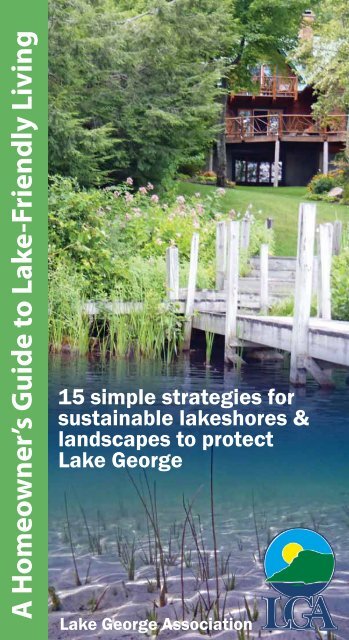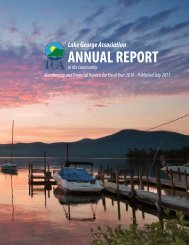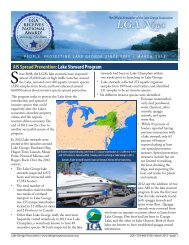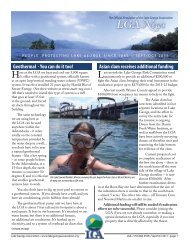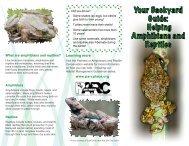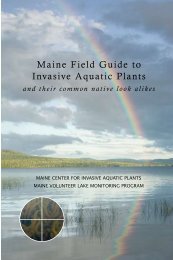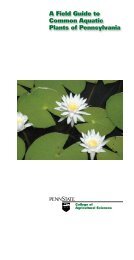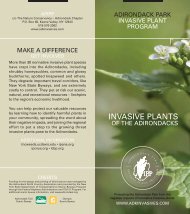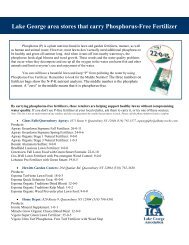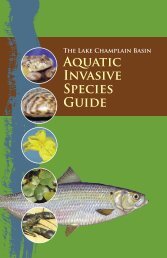"A Homeowner's Guide to Lake-Friendly Living". - Lake George ...
"A Homeowner's Guide to Lake-Friendly Living". - Lake George ...
"A Homeowner's Guide to Lake-Friendly Living". - Lake George ...
You also want an ePaper? Increase the reach of your titles
YUMPU automatically turns print PDFs into web optimized ePapers that Google loves.
A Homeowner’s <strong>Guide</strong> <strong>to</strong> <strong>Lake</strong>-<strong>Friendly</strong> Living<br />
15 simple strategies for<br />
sustainable lakeshores &<br />
landscapes <strong>to</strong> protect<br />
<strong>Lake</strong> <strong>George</strong><br />
<strong>Lake</strong> <strong>George</strong> Association
Recent studies have linked water quality with property values on lakes<br />
throughout the US from Minnesota <strong>to</strong> Maine. <strong>Lake</strong>shore properties are in<br />
demand, and the value of these properties depends upon the quality of the<br />
lake. People prefer clean water and will pay more <strong>to</strong> live on lakes with better<br />
water quality. What you and your neighbors do <strong>to</strong> protect and improve the<br />
water quality of <strong>Lake</strong> <strong>George</strong> will protect your investment in your lakeshore<br />
property.<br />
This guide addresses three main ways <strong>to</strong> protect the water quality of <strong>Lake</strong><br />
<strong>George</strong> and your investment in your lakeshore property. If we all practice<br />
lake-friendly living, we can all enjoy the beauty and health of <strong>Lake</strong> <strong>George</strong><br />
for years <strong>to</strong> come.<br />
Minimize Runoff<br />
Runoff picks up pollutants and carries them <strong>to</strong> the <strong>Lake</strong>.<br />
Minimize the hard surfaces that create runoff.<br />
Minimize Runoff f<br />
Eliminate Pollutants<br />
Eliminate Pollutants<br />
Eliminate pollutants at their source. Avoid using fertilizers,<br />
household <strong>to</strong>xins, and other chemicals. Prevent soil<br />
erosion and failing septic systems.<br />
Capture & Infiiltrate<br />
Capture and Infiltrate<br />
Capture and infiltrate any pollutant-carrying runoff that<br />
you didn’t eliminate before it reaches the <strong>Lake</strong> - with<br />
shoreline buffers, rain barrels, and rain gardens.<br />
To learn more about how you can help protect <strong>Lake</strong><br />
<strong>George</strong>, go online <strong>to</strong> www.lakegeorgeassociation.org or<br />
call 518-668-3558.<br />
1 www.lakegeorgeassociation.org
Working <strong>to</strong>gether<br />
<strong>to</strong> protect <strong>Lake</strong> <strong>George</strong><br />
<strong>Lake</strong> <strong>George</strong>’s beauty has made it<br />
a popular destination. Traditional<br />
summer camps are giving way <strong>to</strong><br />
year-round homes, as more and more<br />
people want <strong>to</strong> enjoy the beauty and<br />
tranquility of lakeside living. The<br />
landscape is dramatically changing as<br />
lots are cleared and driveways paved,<br />
and trees are removed <strong>to</strong> make way<br />
for fertilized lawns. The cumulative<br />
effects from such drastic changes <strong>to</strong><br />
the landscape mean big changes <strong>to</strong><br />
the health of the lake. By changing<br />
the natural environment <strong>to</strong> a suburban<br />
landscape, the lake ecosystem can no<br />
longer function properly.<br />
Leaving the natural <strong>to</strong>pography and<br />
vegetation of the forest floor around<br />
your house protects the lake.<br />
15 simple strategies for<br />
sustainable lakeshores & landscapes<br />
<strong>to</strong> protect <strong>Lake</strong> <strong>George</strong><br />
1. Reduce Impermeable Surfaces<br />
2. Limit Lawn Size<br />
3. Use Water Wisely<br />
4. Minimize Erosion<br />
5. Be Smart About Lawn Care<br />
6. Use Phosphorus-Free Fertilizer<br />
7. Maintain Your Septic System<br />
8. Don’t Flush Your Drugs<br />
9. Maintain Your Vehicles<br />
10. Conserve Water<br />
11. Reduce Household Hazardous Wastes<br />
12. Install a Vegetative Buffer<br />
13. Plant a Rain Garden<br />
14. Go Native<br />
15. Join the LGA Today!<br />
Minimize Runoff f<br />
Eliminate Pollutants<br />
Capture & Infiiltrate<br />
www.lakegeorgeassociation.org 2
S<strong>to</strong>rmwater Runoff<br />
S<strong>to</strong>rmwater runoff isn’t just a problem along<br />
roads and commercial areas. Residential<br />
properties generate runoff as well. S<strong>to</strong>rmwater<br />
runoff from developed areas is the greatest<br />
threat <strong>to</strong> the water quality of <strong>Lake</strong> <strong>George</strong>.<br />
What is s<strong>to</strong>rmwater runoff ?<br />
After a rain event, water that falls on natural<br />
surfaces infiltrates in<strong>to</strong> the ground and<br />
eventually in<strong>to</strong> the groundwater. Water that<br />
falls on impermeable surfaces, such as roads<br />
and parking lots, cannot soak in<strong>to</strong> the ground,<br />
and instead moves across these surfaces.<br />
As impermeable surfaces increase and water<br />
can’t soak in<strong>to</strong> the ground, runoff across the<br />
surface increases. These surfaces increase the<br />
velocity of the runoff and also add pollution.<br />
Oils, salt, and sediment carrying phosphorous<br />
or other chemicals are picked up by the water<br />
as it travels and are all deposited in<strong>to</strong> the lake.<br />
erosion pic<br />
What are the effects<br />
of s<strong>to</strong>rmwater runoff?<br />
• Sediments can cloud<br />
water, affecting plants,<br />
fish, and other aquatic life.<br />
• Sediments can form<br />
deltas, impeding<br />
navigation and lake<br />
access, and providing<br />
ideal habitat for invasive<br />
species.<br />
• Excess nutrients can<br />
cause increases in algal<br />
growth.<br />
• Bacteria and pathogens<br />
can make water unsafe for<br />
drinking and swimming.<br />
• Debris - including plastic<br />
bags - can suffocate or<br />
disable aquatic life; such<br />
as ducks and turtles.<br />
• Household hazardous<br />
wastes; such as pesticides,<br />
paints, or mo<strong>to</strong>r oil, can<br />
poison aquatic life.<br />
• Road salt from the winter<br />
increases chloride levels in<br />
the lake.<br />
All of these effects lead<br />
<strong>to</strong> a loss in water quality<br />
- which can increase the<br />
cost <strong>to</strong> treat our water <strong>to</strong><br />
make it safe for drinking<br />
and hurt the economy by<br />
Runoff carrying sediments down English Brook impacting <strong>to</strong>urism and<br />
formed this delta. When the stream reaches the property values.<br />
lake the water slows, and the sediment settles out<br />
in the lake at the mouth of the stream.<br />
3 www.lakegeorgeassociation.org
Simple Step #1<br />
Reduce Impermeable Surfaces<br />
Minimize Runoff f<br />
Permeable surfaces allow water <strong>to</strong> infiltrate and soak in<strong>to</strong> the ground.<br />
Impermeable surfaces do just the opposite. When water hits this kind of<br />
surface, instead of soaking in, it runs off. This is what creates s<strong>to</strong>rmwater<br />
runoff. The larger the area of impermeable surface, the greater the volume of<br />
s<strong>to</strong>rmwater runoff.<br />
Ways <strong>to</strong> lessen your<br />
impermeable footprint:<br />
• Keep paved driveways as small as possible.<br />
Use permeable surfaces for driveways and<br />
overflow parking areas that aren’t needed on<br />
a regular basis. While gravel driveways may<br />
start off permeable, over time the compaction<br />
makes them nearly as impermeable as regular<br />
asphalt.<br />
• Roof<strong>to</strong>ps are impermeable <strong>to</strong>o - so keep your<br />
home a modest size and build up - not out - on<br />
lakeshore lots.<br />
• Use s<strong>to</strong>ne pathways or stepping s<strong>to</strong>nes<br />
across your lawn instead of poured concrete or<br />
asphalt paths.<br />
•Try one of the newer permeable pavement<br />
technologies. There are permeable paver<br />
systems, asphalt, and concrete - so you can get<br />
just about any look you want. Prices vary - and<br />
while all options are generally more expensive<br />
than traditional pavements, it is definitely<br />
money well spent.<br />
Below: Permeable pavers being installed at the<br />
LGA office. S<strong>to</strong>p by <strong>to</strong> check them out!<br />
www.lakegeorgeassociation.org<br />
4
Simple Step #2<br />
Limit Lawn Size<br />
Minimize Runoff f<br />
Look at the forest all around us. Natural<br />
wooded areas have multiple layers of<br />
vegetation. A canopy of tall trees, an<br />
unders<strong>to</strong>ry of smaller trees and shrubs,<br />
and a groundcover of ferns and other<br />
plants. Branches and the leaf litter from<br />
all these plants build up on the forest<br />
floor over time and break down in<strong>to</strong> a<br />
layer, called duff, that covers the ground.<br />
Duff protects the soil from the impact of<br />
rain, keeping the soil in place instead of<br />
letting it erode away. The roots of plants<br />
and trees in the forest also hold the duff<br />
in place. Water soaks in<strong>to</strong> the ground,<br />
filtering pollutants and replenishing<br />
groundwater. Studies have found that<br />
areas of lawn can create more runoff<br />
than similarly sized wooded areas.<br />
The plants and leaf litter on the<br />
forest floor lessen the impact of rain<br />
and allow it <strong>to</strong> soak in<strong>to</strong> the ground<br />
instead of running off across the<br />
surface.<br />
Lawns absorb less rainfall than natural areas.<br />
• Grading a lot <strong>to</strong> create a lawn removes the natural <strong>to</strong>pography of the land.<br />
Low spots where water would naturally collect and have time <strong>to</strong> soak in are<br />
lost.<br />
• Heavy machinery and equipment compact the soils during construction,<br />
leaving no space in the soil for water <strong>to</strong> soak in.<br />
• Without the branches and leaves of trees and shrubs <strong>to</strong> intercept the<br />
rainfall and lessen its impact, rain hits the ground hard and runs off across<br />
the surface.<br />
When building a new home, think about<br />
how you will use your lawn. Would you like<br />
an area for children <strong>to</strong> play? Or for a pet <strong>to</strong><br />
exercise? Then, plan accordingly. Only<br />
create as much lawn area as you need.<br />
If you have a large existing lawn that you<br />
don’t use, start making it smaller by<br />
planting more trees and shrubs around<br />
the edges, and eventually work<br />
your way in.<br />
5<br />
www.lakegeorgeassociation.org
Simple Step #3<br />
Use Water Wisely<br />
Minimize Runoff f<br />
Using water wisely around the yard helps prevent<br />
pollution from s<strong>to</strong>rmwater runoff.<br />
If you have an irrigation system:<br />
• Water your lawn and garden in the morning<br />
or evening when temperatures are cooler <strong>to</strong><br />
minimize evaporation.<br />
• Adjust sprinklers so only your lawn is watered<br />
and not the house, sidewalk, or street.<br />
• Install a rain sensor on your irrigation controller so your system won’t run<br />
when it’s raining.<br />
• Choose shrubs and groundcovers instead of turf for<br />
hard-<strong>to</strong>-water areas such as steep slopes and isolated<br />
strips.<br />
• Spread a layer of organic mulch around plants <strong>to</strong><br />
retain moisture and save water, time and money.<br />
• Use drip irrigation for shrubs and trees <strong>to</strong> apply<br />
water directly <strong>to</strong> the roots where it’s needed.<br />
Or better yet, landscape with native plants that won’t<br />
need irrigation once they are established. This will<br />
save water and save you the cost of the installation<br />
and maintenance of an irrigation system!<br />
Barren strawberry<br />
is a great native<br />
groundcover that is<br />
drought resistant.<br />
Other ways <strong>to</strong> prevent runoff from your property:<br />
• Install a rain barrel <strong>to</strong> collect runoff from your roof and <strong>to</strong> use for watering<br />
your garden.<br />
• Direct your downspouts on<strong>to</strong> your lawn or<br />
in<strong>to</strong> a rain garden, away from your driveway<br />
and other impermeable surfaces.<br />
• Install covers on pools and spas and check<br />
for leaks around pumps.<br />
• Check for leaking outdoor faucets.<br />
• Use a broom instead of a hose <strong>to</strong> clean<br />
driveways and sidewalks.<br />
• Patios provide space that doesn’t ever<br />
need <strong>to</strong> be watered. These useful “outdoor<br />
rooms” can also add value <strong>to</strong> your property.<br />
Just be sure <strong>to</strong> keep it permeable!<br />
www.lakegeorgeassociation.org<br />
6
Simple Step #4<br />
Minimize Erosion<br />
Eliminate Pollutants<br />
When you are planning a construction project,<br />
check with your local municipality and the <strong>Lake</strong><br />
<strong>George</strong> Park Commission <strong>to</strong> determine whether<br />
or not you need a permit. Be sure <strong>to</strong> have an<br />
erosion control plan in place before you begin.<br />
Depending on the type of project, you might<br />
need <strong>to</strong>:<br />
• Preserve existing vegetation where possible <strong>to</strong><br />
prevent erosion. Avoid parking or driving heavy<br />
machinery near trees as soil compaction can<br />
damage their roots.<br />
• Build a gravel access drive <strong>to</strong> limit compaction of<br />
your site and <strong>to</strong> limit the mud that is tracked out <strong>to</strong> the street from vehicles<br />
leaving the site.<br />
• Properly install a silt fence or straw bales <strong>to</strong> trap sediment on the downslope<br />
side of your lot.<br />
• Protect soil piles with silt fences and by keeping them covered with tarps<br />
or plastic. Locate the piles away from the road or nearby water <strong>to</strong> lessen the<br />
chance of sediment being transported off-site.<br />
• Replant the area as soon as possible so that there is not bare soil. Cover<br />
lawn areas with 4-6” of <strong>to</strong>psoil and then seed and mulch with straw.<br />
• Fence the construction area <strong>to</strong> limit activity <strong>to</strong> only the necessary area of<br />
the site. This will help reduce erosion and unneccessay soil compaction of<br />
the rest of your property.<br />
• Divert runoff around disturbed areas <strong>to</strong> minimize erosion.<br />
Sediment fences are the last line of defense<br />
from s<strong>to</strong>pping sediments from washing off your<br />
site. They should not be relied upon as the sole<br />
solution for erosion control and they must be<br />
installed properly in order <strong>to</strong> be effective.<br />
This site was seeded and mulched with straw <strong>to</strong><br />
cover the bare soil and the silt fence stayed in<br />
place until the grass seed had a chance <strong>to</strong> grow<br />
and stabilize the soil. Larger plants were also<br />
planted <strong>to</strong> help revegetate the disturbed area. It<br />
is important <strong>to</strong> keep erosion control measures<br />
in place until the site has been restabilized.<br />
Remember - just because the construction is done,<br />
doesn’t mean it is time <strong>to</strong> pack things up just yet!<br />
7<br />
www.lakegeorgeassociation.org
Simple Step #5<br />
Be Smart about Lawn Care<br />
Eliminate Pollutants<br />
Fertilizers, leaves, grass clippings,<br />
animal waste, and eroded soil are all<br />
sources of phosphorus. When they<br />
are swept or washed in<strong>to</strong> the street<br />
or nearest s<strong>to</strong>rm drain, they end up<br />
in a nearby stream or the lake. Follow<br />
these tips for smart lawn care with<br />
water quality in mind.<br />
• Apply fertilizer at the recommended<br />
rate. Fall is the best time. Don’t fertilize<br />
before a s<strong>to</strong>rm. Never apply <strong>to</strong> frozen<br />
ground. Or better yet, skip the fertilizer<br />
all <strong>to</strong>gether!<br />
• Yard waste can contribute significant amounts of phosphorus <strong>to</strong> water<br />
ways. Keep soil, leaves, and lawn clippings out of the street, ditches, s<strong>to</strong>rm<br />
drains, and streams by bagging them, composting them, or leaving them<br />
right on the lawn as a natural fertilizer.<br />
• Mow higher. Keep grass length <strong>to</strong> 2½ – 3 inches. It is healthier for your lawn<br />
- and means you can mow less often!<br />
Mow Your Way <strong>to</strong> Clean Water. Lawn care practices can have a big<br />
impact on water quality and the environment.<br />
• Pick up pet waste. Pet waste can contain harmful bacteria as well as<br />
phosphorus. Flush it in the <strong>to</strong>ilet or place it in the garbage.<br />
• Build healthy soil using compost and other natural amendments. Healthy<br />
soils are more resistant <strong>to</strong> disease and insect problems.<br />
• Learn about Integrated Pest Management (IPM) and use pesticides<br />
sparingly and only when really needed. Do not apply pesticides as part of a<br />
‘routine maintenance plan’. When use is needed, be sure <strong>to</strong> follow the label.<br />
Often the timing of the application is critical <strong>to</strong> its success. There are many<br />
organic products available at s<strong>to</strong>res - try these first - and only use chemicals<br />
as a last resort.<br />
www.lakegeorgeassociation.org<br />
8
Phosphorus & Water Quality<br />
What is Phosphorus?<br />
Phosphorus is a natural element<br />
and an essential nutrient for<br />
plant growth but is found only<br />
in small amounts in lakes and<br />
streams. Even small increases<br />
in phosphorus can have a<br />
devastating impact on the<br />
water quality of a lake or stream.<br />
Increased phosphorus can<br />
stimulate algae and excessive plant growth. Boating, fishing, and swimming<br />
can become difficult and lake shore property values and <strong>to</strong>urism can also be<br />
negatively impacted.<br />
Green and Gross<br />
Excess phosphorus can lead <strong>to</strong> an explosion of algal<br />
growth in the lake. 1 lb of phosphorus can produce<br />
up <strong>to</strong> 500 pounds of wet algae!<br />
GREEN AND GOOEY Excess<br />
phosphorus leads <strong>to</strong> an explosion of<br />
More plant growth Phosphorus, and algae blooms in Less Fish<br />
lakes.<br />
As algae die and decay, the water is robbed of dissolved<br />
oxygen. This can devastate fish populations if it occurs for<br />
a long period of time or the fish have no where else <strong>to</strong> go.<br />
Where Does Phosphorus Come From?<br />
Phosphorus has many sources. Some exists naturally in lakes and streams<br />
but human activities from residential and agricultural areas contribute a<br />
significant amount of phosphorus. S<strong>to</strong>rmwater runoff travels across land<br />
and picks up phosphorus from fertilizers, eroded soil particles, septic systems<br />
and pet waste and discharges it in<strong>to</strong> nearby streams and the lake.<br />
Urbanized areas account for only 5% of <strong>Lake</strong> <strong>George</strong>’s watershed area but<br />
create 43% of the annual phosphorus loading <strong>to</strong> the <strong>Lake</strong>. Sediments wash<br />
in<strong>to</strong> streams and out in<strong>to</strong> the lake, bringing phosphorus attached <strong>to</strong> the soil<br />
particles. One way <strong>to</strong> help s<strong>to</strong>p this transfer of phosphorus in<strong>to</strong> the lake is <strong>to</strong><br />
s<strong>to</strong>p the sources of it, such as fertilizers containing phosphorus.<br />
9 www.lakegeorgeassociation.org
Simple Step #6<br />
Use Phosphorus-Free Fertilizer<br />
Eliminate Pollutants<br />
What do I look for?<br />
The three numbers in fertilizer bags show the N-P-K<br />
nutrient analysis. The middle number is the phosphate<br />
(phosphorus) content. A “zero” in the middle means it is<br />
phosphorus-free.<br />
Will phosphorus-free fertilizer<br />
keep my lawn green & healthy?<br />
Yes! Soils in most parts of New York already<br />
have an adequate amount of phosphorus<br />
<strong>to</strong> grow a healthy lawn. In these instances,<br />
adding more phosphorus with fertilizer is<br />
not needed and will not benefit your lawn.<br />
How do I find out what my soil needs?<br />
If you are concerned that your lawn may need phosphorus, you can<br />
have your soil tested. Soil testing is available through your local Cornell<br />
Cooperative Extension office for a reasonable fee.<br />
Besides being lake-friendly - It is now the Law!<br />
Beginning on January 1, 2012, New York State law prohibits:<br />
• the use of phosphorus-containing lawn fertilizer unless you are establishing<br />
a new lawn or a soil test shows that your lawn does not have enough<br />
phosphorus,<br />
• the application of lawn fertilizer on impervious surfaces, (Picking up<br />
fertilizer applied or spilled on<strong>to</strong> impervious surfaces is required.)<br />
• the application of lawn fertilizer within 20 feet of any surface water except:<br />
where there is a vegetative buffer of at least 10 feet; or where the fertilizer is<br />
applied by a device with a spreader guard, deflec<strong>to</strong>r shield or drop spreader<br />
and is applied at least three feet from surface water,<br />
• the application of any lawn fertilizer between December 1 and April 1.<br />
The law also requires retailers <strong>to</strong> display phosphorus-containing fertilizers<br />
separately from non-phosphorus fertilizers and <strong>to</strong> post an educational sign<br />
where the phosphorus-containing fertilizers are displayed.<br />
The law does not apply <strong>to</strong> agricultural fertilizer or fertilizer for gardens.<br />
www.lakegeorgeassociation.org<br />
10
Eliminate Pollutants<br />
Septic Systems<br />
Simple Step #7<br />
Maintain Your Septic System<br />
Maintaining your onsite wastewater treatment system (OWTS) - or septic<br />
system - not only protects <strong>Lake</strong> <strong>George</strong> and nearby groundwaters from<br />
being contaminated, but also protects your health and your investment<br />
in your home. Typical pollutants found in household wastewater include<br />
nitrogen, phosphorus, and disease-causing bacteria and viruses. A properly<br />
designed, constructed, and maintained system can provide long-term,<br />
effective treatment of household wastewater. If not properly maintained, a<br />
failing system can cost tens of thousands of dollars <strong>to</strong> replace.<br />
Know the signs of a<br />
failed system:<br />
• Pooling water or muddy soil<br />
around the tank or drainfield<br />
or in your basement.<br />
• Bad smell coming from area<br />
of tank.<br />
• Toilet or sink backs up when<br />
you flush or do laundry.<br />
• Bright green grass over the<br />
drainfield.<br />
If you notice any of these<br />
signs - call a professional <strong>to</strong><br />
have your system looked at<br />
right away.<br />
A typical septic system<br />
has 4 main parts:<br />
• a pipe from the home that carries the<br />
wastewater in<strong>to</strong> the tank;<br />
• a tank that holds the water long enough<br />
for the solids <strong>to</strong> settle out <strong>to</strong> the bot<strong>to</strong>m<br />
and the oil and grease <strong>to</strong> float <strong>to</strong> the surface;<br />
• a drainfield where the water from the<br />
tank is discharged;<br />
• the soil where the microbes provide the<br />
final treatment.<br />
Alternative Systems<br />
Due <strong>to</strong> unsuitable soils, high bedrock or groundwater, or small lot size you<br />
may have a hard time making a traditional septic system work on your<br />
property.<br />
There are alternative systems now available that use new technologies<br />
<strong>to</strong> improve treatment processes, many of which need less space <strong>to</strong><br />
function. Such systems use sand, peat<br />
or plastic media instead of soil <strong>to</strong> treat<br />
the wastewater. Many of these systems<br />
are already being used on <strong>Lake</strong> <strong>George</strong>.<br />
Contact our office <strong>to</strong> learn more about<br />
these alternative systems. Pho<strong>to</strong> at left is a<br />
Puraflo system that uses peat moss as a filter.<br />
11 www.lakegeorgeassociation.org
How <strong>to</strong> Maintain your System:<br />
1. Regularly inspect your system and pump your tank as necessary.<br />
It’s a good idea <strong>to</strong> have your system inspected every 2-3 years. In general,<br />
it should be pumped every 3-5 years but this depends on how much your<br />
system is used and its size. Your inspec<strong>to</strong>r can determine when it is time <strong>to</strong><br />
pump your tank. If you don’t pump your tank routinely, the solids in the<br />
bot<strong>to</strong>m can build up and make their way out in<strong>to</strong> your leachfield, clogging it<br />
and eventually ruining it. You might not know you have a problem until it is<br />
<strong>to</strong>o late and you need a new leachfield.<br />
2. Don’t dispose of household hazardous wastes in sinks or <strong>to</strong>ilets.<br />
Avoid paints, chemicals, cleaners, gasoline, oil, or other <strong>to</strong>xic materials that<br />
could kill the good bacteria in your system. Avoid things that can clog pipes<br />
such as diapers, coffee grounds, feminine hygiene products, paper <strong>to</strong>wels,<br />
and grease and fat from cooking. Avoid frequent use of a garbage disposal.<br />
Normal use of antibacterial products such as handsoap is fine but excessive<br />
use might kill <strong>to</strong>o many beneficial bacteria in your system and prevent it<br />
from working properly. Septic additives are not needed.<br />
3. Care for your drainfield. Plant only grass or groundcover with shallow<br />
roots over or near your drainfield. Deep roots could clog and damage the<br />
drainfield. Don’t drive or park vehicles on the drainfield either. This could<br />
compact soil or damage the pipes. Keep roof drains, sump pump drains, and<br />
other surface water runoff away from the drainfield <strong>to</strong> avoid flooding it.<br />
4. Use water efficiently. Using less water means less water going through<br />
your septic system. This helps it operate properly and reduces stress on your<br />
system and the risk of a failure.<br />
Avoid overloading your system with more water than it is meant <strong>to</strong> handle.<br />
• Don’t do multiple loads of laundry all in one day - spread it out instead.<br />
• Don’t drain a hot tub or pool in<strong>to</strong> your tank or over your drainfield.<br />
• Some water softeners or filters flush themselves daily. Make sure these<br />
aren’t discharging in<strong>to</strong> your system.<br />
www.lakegeorgeassociation.org<br />
12
Simple Step #8<br />
Don’t Flush Your Drugs<br />
Eliminate Pollutants<br />
Until recently, consumers have been <strong>to</strong>ld<br />
<strong>to</strong> flush old drugs down the <strong>to</strong>ilet, or pour<br />
them down the drain. We now know that<br />
such actions can have many detrimental<br />
effects. Some drugs pass largely unaltered<br />
through wastewater treatment systems. A<br />
nationwide study found low levels of drugs<br />
such as antibiotics, hormones, contraceptives and steroids in 80% of the<br />
rivers and streams tested throughout the U.S.<br />
What should be done with unwanted drugs?<br />
The best option is <strong>to</strong> take medications <strong>to</strong> a special local collection site<br />
or event. (Most household hazardous waste collection events will not<br />
accept pharmaceuticals.) Go <strong>to</strong> www.dontflushyourdrugs.net <strong>to</strong> find a<br />
collection event in our area. The next best thing <strong>to</strong> do is <strong>to</strong> dispose of your<br />
medications in the trash, following these steps:<br />
• Add water and then mix ashes, dirt, cat litter, coffee grounds, or another<br />
undesirable substance <strong>to</strong> the medication.<br />
• Hide all medications in an outer container, such as a sealable bag, box or<br />
plastic tub. Seal the container with strong tape.<br />
• Dispose of drugs as close <strong>to</strong> your trash collection day as possible <strong>to</strong> avoid<br />
accidental or intentional misuse.<br />
• Avoid crushing pills as some medications can be harmful in powder form.<br />
• To prevent consumption by scavenging humans, pets or wildlife, do not<br />
conceal discarded drugs in food.<br />
Eliminate Pollutants<br />
Simple Step #9<br />
Maintain Your Vehicles<br />
Most people might link cars <strong>to</strong> air pollution, but all the fluids found in a car<br />
can be very detrimental <strong>to</strong> water quality as well.<br />
• Make sure your car is not leaking oil or other fluids on<strong>to</strong> your driveway or<br />
on<strong>to</strong> the road where it can be washed in<strong>to</strong> nearby waterways.<br />
• If you change your own oil, use an oil pan <strong>to</strong> catch any drips. If the oil spills,<br />
don’t wash it in<strong>to</strong> the nearest s<strong>to</strong>rmdrain with the hose. Instead, clean it up<br />
with an absorbent material such as kitty litter and then dispose of it properly.<br />
• Wash your car on your lawn - or better yet - take it <strong>to</strong> a commercial car<br />
wash where the wash water is captured, cleaned, recycled, and reused.<br />
Soapy water contains phosphosus and other chemicals that can harm fish<br />
and water quality.<br />
13 www.lakegeorgeassociation.org
Simple Step #10<br />
Conserve Water In Your Home<br />
Eliminate Pollutants<br />
Water conservation in the home helps maintain your<br />
septic system. Here are some ways <strong>to</strong> use water more<br />
efficiently around your home :<br />
• Install high-efficiency showerheads. They’re inexpensive,<br />
easy <strong>to</strong> install, and can save you up <strong>to</strong> 750 gallons a month.<br />
• Turn off faucets while shaving or brushing your teeth.<br />
• Compost vegetable waste instead of using the garbage disposal.<br />
• Run the dishwasher only when full.<br />
• Don’t use running water <strong>to</strong> thaw food.<br />
• Make sure all faucets are completely turned off when<br />
not in use.<br />
• Install aera<strong>to</strong>rs in the faucets in your kitchen and<br />
bathroom.<br />
• Replace old dishwashers, <strong>to</strong>ilets, and washing<br />
machines with new, high-efficiency models. New<br />
washing machines with the Energy Star label use<br />
only 18 - 25 gallons of water per load (compared <strong>to</strong><br />
40 gallons per load for the typical machine) and save<br />
about 7,000 gallons of water a year.<br />
Did you Know ?<br />
Average indoor<br />
water use in a typical<br />
single-family home<br />
is almost 70 gallons<br />
per person per day.<br />
Simple Step #11<br />
Reduce Household<br />
Hazardous Wastes<br />
Eliminate Pollutants<br />
Household hazardous waste is any waste produced in the home, which is<br />
flammable, <strong>to</strong>xic, corrosive, or reactive. Common examples include: gasoline,<br />
oil, solvents, paints, paint thinners, fertilizers, pesticides, cleaners, and<br />
batteries.<br />
Use these products with care <strong>to</strong> avoid damaging your health. Improperly<br />
disposed of paints and chemicals can pollute local waters.<br />
• Use hazardous substances in the smallest amounts possible.<br />
• Use non-<strong>to</strong>xic, biodegradable products when possible.<br />
• Recycle products whenever possible or share with a neighbor.<br />
• Clean paint brushes and other supplies in a sink, not outside.<br />
• Always follow the directions on the label and s<strong>to</strong>re properly <strong>to</strong> avoid leaks<br />
or spills. S<strong>to</strong>re hazardous products until they can be safely disposed of at a<br />
household hazardous waste collection event.<br />
www.lakegeorgeassociation.org<br />
14
Simple Step #12<br />
Install a Vegetative Buffer<br />
Capture & Infiiltrate<br />
More and more people are building year-round or second homes<br />
on <strong>Lake</strong> <strong>George</strong>. They often bring their idea of a conventional<br />
yard with them, leading <strong>to</strong> a grass<br />
lawn down <strong>to</strong> the lakeshore.<br />
Traditional lawns on a lakeshore can cause:<br />
• Excessive plant and algal growth,<br />
• Shoreline erosion and sedimentation,<br />
• Loss of wildlife habitat,<br />
• An increase in nuisance animals,<br />
• Loss of leisure time.<br />
A naturally landscaped<br />
yard adds value <strong>to</strong> your<br />
property and can also<br />
benefit <strong>Lake</strong> <strong>George</strong>’s water<br />
quality and overall health.<br />
What is a vegetative buffer?<br />
A vegetative buffer, or buffer zone, is a strip of natural vegetation along the<br />
shoreline of a lake or waterbody.<br />
Ideally, the vegetation should cover at least 50-75% of the property’s lake<br />
frontage.<br />
By res<strong>to</strong>ring the shoreline with native plants, you res<strong>to</strong>re the ecological<br />
functions of the lakeshore. The benefits of buffers include:<br />
• Food and shelter for local wildlife,<br />
• Stabilized soil and reduced erosion,<br />
• Filtration of pollutants and sediments,<br />
• Absorption of nutrients,<br />
• Deterrence of nuisance species,<br />
• Privacy from lake users,<br />
• Save time and money in maintenance.<br />
Got geese?<br />
Canada geese love short, tender grass and avoid tall<br />
grass where preda<strong>to</strong>rs can hide. A shoreline buffer will<br />
send the geese packing.<br />
15 www.lakegeorgeassociation.org
Use the natural landscape<br />
as your guide<br />
A canopy of trees above, shrubs and<br />
flowers in the middle, and groundcover<br />
below provides multiple layers <strong>to</strong> intercept<br />
the rain. If you don’t have room for trees<br />
on your property - use large shrubs,<br />
flowers, and groundcover <strong>to</strong> create your<br />
layers instead. You can protect the<br />
<strong>Lake</strong>’s water quality and still have an<br />
amazing view at the same time!<br />
Lucky enough <strong>to</strong> have a natural<br />
vegetative buffer along your shoreline?<br />
Leave it! Mother Nature knows best.<br />
Not so lucky? That’s ok. You can<br />
plant a new vegetative buffer along your<br />
shoreline just as these homeowners did.<br />
It will mature in no time, and will protect<br />
your investment in your property for<br />
years <strong>to</strong> come.<br />
What should I plant?<br />
S<strong>to</strong>p by the LGA office <strong>to</strong> pick up a list of recommended<br />
native plants for buffers on <strong>Lake</strong> <strong>George</strong>. You can also<br />
check out our demonstration plantings at our office or<br />
find plant lists on our website.<br />
Right Plant. Right Place.<br />
<strong>Lake</strong> <strong>George</strong> is zone 4b/5a of the plant hardiness zones<br />
- so be sure any plants you pick are meant for zone 4 or<br />
colder <strong>to</strong> play it safe. You will also need <strong>to</strong> consider the<br />
soil type, sunlight, drainage and slope on your site.<br />
How do I get started?<br />
Look around at natural areas <strong>to</strong> see what plants are<br />
growing there. There are also many plant lists available<br />
online or available at the LGA office. Want professional<br />
help? We can visit your site and provide advice, help<br />
you find a local landscaper with experience planting<br />
buffers, or help educate your current landscaping team.<br />
www.lakegeorgeassociation.org 16
Simple Step #13<br />
Plant a Rain Garden<br />
Capture & Infiiltrate<br />
A rain garden is a vegetated depression that collects rainwater. This allows<br />
the rain that falls on roof<strong>to</strong>ps, driveways, and patios <strong>to</strong> infiltrate in<strong>to</strong> the<br />
ground instead of becoming s<strong>to</strong>rmwater runoff.<br />
Rain gardens are beneficial in many ways:<br />
• Help keep water clean by filtering s<strong>to</strong>rmwater runoff before it enters<br />
local waterways.<br />
• Help alleviate problems with flooding and drainage.<br />
• Enhance the beauty of yards and communities.<br />
• Provide habitat and food for wildlife like birds and butterflies.<br />
• Reduce the need for expensive s<strong>to</strong>rmwater treatment structures in your<br />
community.<br />
Getting Started:<br />
The first step is sizing and siting your rain garden. You want <strong>to</strong> pick a location<br />
on your property that you can direct a downspout or other source of runoff<br />
<strong>to</strong>. It should be at least 10 ft. from your home’s foundation and flat or gently<br />
sloping. A typical homeowner rain garden is around 100-300 sq. ft.<br />
and 4-8 inches deep. Just how big your rain garden should be will<br />
depend on your soils, slope, and the size of the area that drains<br />
<strong>to</strong> the garden.<br />
17 www.lakegeorgeassociation.org
Time <strong>to</strong> Dig!<br />
After you have planned out your garden size,<br />
shape, and location, it is time <strong>to</strong> start digging.<br />
You can use a hose, string, or spray paint <strong>to</strong><br />
outline the shape of your garden <strong>to</strong> help keep<br />
you digging in the right place. As you dig, use<br />
the soil you are removing <strong>to</strong> create the berm<br />
around three sides of your garden <strong>to</strong> hold the<br />
water in. The fourth side isn’t built up because<br />
that is where the water flows in. You want the<br />
bot<strong>to</strong>m of your garden <strong>to</strong> be level. You can<br />
‘eyeball’ it - or get out a level <strong>to</strong> be sure.<br />
Where <strong>to</strong> Dig<br />
Where <strong>to</strong> Put the Soil You’ve Dug<br />
Oxeye Sunflower<br />
Native Plants for<br />
Rain Gardens<br />
Tall White Beard<strong>to</strong>ngue<br />
New England Aster<br />
White Turtlehead<br />
Blue Flag Iris<br />
Culver’s Root<br />
Joe Pye Weed<br />
Labrador Violet<br />
Cardinal Flower<br />
Wild Geranium<br />
Beebalm<br />
Great Blue Lobelia<br />
Foamflower<br />
Switchgrass<br />
Planting the Garden<br />
Since a rain garden is flooded periodically, you<br />
need plants that can live in both wet and dry<br />
conditions. You should also consider if your<br />
site is sunny or shady when selecting plants.<br />
You might want a variety of height, color, and<br />
blooming period as well. This way your rain<br />
garden is not only s<strong>to</strong>pping s<strong>to</strong>rmwater runoff<br />
but is also providing a beautiful landscape <strong>to</strong><br />
enjoy all summer long.<br />
Plant a rain garden - and you’ll be<br />
excited when it rains!<br />
Swamp<br />
Milkweed<br />
These are just a few of the<br />
plants you can use in a<br />
rain garden.<br />
S<strong>to</strong>p by our office and<br />
check out the lists that we<br />
have available for more<br />
detailed info and <strong>to</strong> find<br />
some plants that will work<br />
well for your own rain<br />
garden.<br />
www.lakegeorgeassociation.org 18
Simple Step #14<br />
Go Native!<br />
Capture & Infiiltrate<br />
What is a native plant?<br />
Native plants are indigenous <strong>to</strong> an area at the time of European settlement.<br />
Japanese knotweed along roadway<br />
What is an invasive plant?<br />
An invasive plant is a non-native<br />
plant that grows out of control,<br />
out-competing our native plants<br />
for nutrients, sunlight, and space.<br />
Invasives cause harm <strong>to</strong> the<br />
environment, the economy, and some<br />
can even be dangerous for our health!<br />
Invaders for Sale<br />
You may already know about common roadside<br />
invaders such as Japanese knotweed, but it may<br />
surprise you that many popular plants still sold<br />
at garden and nursery centers are also invasive.<br />
Here is a list of plants that you should avoid<br />
buying. The worst ac<strong>to</strong>rs are bolded.<br />
Burning bush is very popular<br />
for its red fall color - but it is<br />
very invasive and has already<br />
been banned in some states!<br />
Autumn Olive Elaeagnus umbellata Goutweed Aegopodium podagraria<br />
Black Locust Robinia pseudoacacia Indian Cup Plant Silphium perfoliatum<br />
Border Privet Ligustrum obtusifolium Japanese Barberry Berberis thunbergii<br />
Burning Bush Euonymus alatus<br />
Multiflora Rose Rosa Multiflora<br />
Callery (Bradford) Pear Pyrus calleryana Norway Maple Acer platanoides<br />
Common Buckthorn Rhamnus cathartica Oriental Bittersweet Celastrus orbiculatus<br />
Common Periwinkle Vinca minor Porcelainberry Ampelopsis brevipedunculata<br />
Creeping Jenny Lysimachia nummularia Purple Loosestrife Lythrum salicaria<br />
Crown Vetch Coronilla varia<br />
Shrubby Honeysuckles Lonicera spp.<br />
English Ivy Hedera helix<br />
Wintercreeper Euonymus fortunei<br />
Garden Loosestrife Lysimachia vulgaris Yellow Iris Iris pseudacorus<br />
19<br />
www.lakegeorgeassociation.org
The Benefits of Native Species<br />
With all the benefits that native plants provide, you can feel good about<br />
enjoying the beautiful landscape all around you.<br />
Native plants:<br />
• Help protect New York’s biodiversity by providing food and habitat for<br />
birds, butterflies, and other wildlife.<br />
• Save you time and money. Natives have evolved in our environment<br />
over many years and are already adapted <strong>to</strong> survive here; they<br />
are low maintenance and don’t need lots of fertilizer, pesticides, and watering.<br />
• Help reduce s<strong>to</strong>rmwater runoff. The deep roots of natives absorb and<br />
filter runoff more effectively than the short roots of many turf grasses<br />
and other ornamental plants.<br />
The extensive roots of native plants improve<br />
the ability of the soil <strong>to</strong> infiltrate water and <strong>to</strong><br />
resist erosion. In fact, native plants often have<br />
more biomass below the surface than above.<br />
For example, little bluestem, a great bunch<br />
grass for the garden, only grows 2-3’ tall, but<br />
can have roots up <strong>to</strong> 8 feet deep.<br />
The shallow roots of<br />
turf grass are better<br />
than bare soil, but<br />
pale in comparison <strong>to</strong><br />
native plants. Kentucky<br />
bluegrass is shown in the<br />
drawing above.<br />
So many choices...<br />
Native plants come in just about every size, shape, and<br />
color. You can design a native plant garden for interest<br />
in all 4 seasons, or a theme garden based on form or<br />
function. Here are just a few ideas <strong>to</strong> get you started.<br />
Dogwoods<br />
Viburnums<br />
Bayberry<br />
Blue Vervain<br />
Culvers Root<br />
Bergamot<br />
Cardinal Flower<br />
Wild Columbine<br />
Fireweed<br />
Hummingbirds<br />
Birds<br />
Deer Resistant<br />
Bee Balm<br />
Beard<strong>to</strong>ngue<br />
Trumpet Honeysuckle<br />
Serviceberry<br />
Chokeberry<br />
Cutleaf coneflower<br />
Foamflower<br />
Sensitive Fern<br />
Bugbane<br />
Milkweeds<br />
Joe Pye Weeds<br />
Asters<br />
Winterberry<br />
Summersweet<br />
Spicebush<br />
Blue Vervain<br />
Butterflies<br />
New York Ironweed<br />
Woodland sunflower<br />
Goldenrods<br />
Salt Tolerant<br />
Arrowwood<br />
Elderberry<br />
Witch hazel<br />
We can also help recommend natives for clay or sandy soils, shade, rain<br />
gardens, or whatever you need - just give us a call at the office.<br />
www.lakegeorgeassociation.org 20
Eliminate Pollutants<br />
Simple Step #15<br />
Join the LGA<br />
Since its inception in 1885, the <strong>Lake</strong> <strong>George</strong> Association<br />
has evolved <strong>to</strong> incorporate and address the changing<br />
needs of the <strong>Lake</strong> <strong>George</strong> environment. The LGA<br />
advocates a reasoned, balanced approach <strong>to</strong> the<br />
management and conservation of the <strong>Lake</strong> <strong>George</strong><br />
watershed through education, remediation, advocacy<br />
and broad-based community involvement. Our goal is <strong>to</strong><br />
ensure the long-term stability of the lake’s exceptional<br />
water quality and the economic viability of the region.<br />
LGA <strong>Lake</strong> Saving Project: Sediment retention basin on Hague Brook.<br />
LGA Floating Classroom: Educational adventure <strong>to</strong> learn about <strong>Lake</strong> <strong>George</strong>.<br />
The LGA is a membership organization. We can only accomplish our mission<br />
<strong>to</strong> protect <strong>Lake</strong> <strong>George</strong> through the support of our members.<br />
Help us continue protecting the <strong>Lake</strong> by becoming a<br />
member! Call <strong>to</strong>day or visit our website. Your support will<br />
continue <strong>to</strong> be appreciated for generations <strong>to</strong> come.<br />
518-668-3558 www.lakegeorgeassociation.org<br />
21<br />
Credits and References: Thanks <strong>to</strong> UW Extension and Wisconsin DNR for courtesy use of the line<br />
drawings throughout the publication. p. 3: Illustration courtesy Stream Corridor Res<strong>to</strong>ration: Principles,<br />
Processes, and Practices, 10/98, by the Federal Interagency Stream Res<strong>to</strong>ration Working Group<br />
(FISRWG). p. 8-10:Thanks <strong>to</strong> the Onondaga <strong>Lake</strong> Partnership and CCE of Onondaga County for imagery<br />
and language. p. 17: Rain garden pho<strong>to</strong> courtesy of the Cayuga <strong>Lake</strong> Watershed Network, Rain garden<br />
illustration courtesy of Sheri Amsel. p. 18: Rain garden illustrations from University of Wisconsin<br />
Extension, Rain Gardens: A How-<strong>to</strong> Manual for Homeowners. p. 19: Pho<strong>to</strong> credits : Japanese knotweed;<br />
L.J. Mehrhoff, UCONN, Bugwood.org. Burning bush; J.H. Miller, USDA Forest Service, Bugwood.org.<br />
Illustration from UCONN Extension’s Rain Gardens in Connecticut.<br />
www.lakegeorgeassociation.org
The <strong>Lake</strong> <strong>George</strong> Watershed<br />
<strong>Lake</strong> <strong>George</strong><br />
and its watershed<br />
A watershed is an area of land that<br />
drains in<strong>to</strong> a waterbody. It includes<br />
all surface and groundwater.<br />
The <strong>Lake</strong> <strong>George</strong> watershed is 233<br />
square miles, which is about 5<br />
times as big as the <strong>Lake</strong>’s surface.<br />
It includes portions of the three<br />
counties of Warren, Washing<strong>to</strong>n,<br />
and Essex and nine municipalities.<br />
<strong>Lake</strong> <strong>George</strong> holds an estimated<br />
550 billion gallons of water.<br />
Just over half of the water in<br />
<strong>Lake</strong> <strong>George</strong> comes from the 141<br />
streams that flow in<strong>to</strong> the <strong>Lake</strong>.<br />
The rest comes from precipitation<br />
and groundwater.<br />
Watersheds and Water Quality<br />
The formation of <strong>Lake</strong> <strong>George</strong>, with a large, deep basin and steep, forested<br />
slopes surrounding the <strong>Lake</strong>, created crystal clear water and a stunning<br />
landscape. Even <strong>to</strong>day, after decades of development, we enjoy some of the<br />
cleanest and clearest water in the state and some of the most scenic vistas.<br />
However, as development pressures continue <strong>to</strong> increase, the health of our<br />
lake is slowly declining. As more pollutants enter the <strong>Lake</strong>, the lake’s natural<br />
capacity <strong>to</strong> clean itself can’t keep up.<br />
<strong>Lake</strong> <strong>George</strong> has a very long retention time, over 8 years. This means that<br />
it takes a very long time for water, and any pollution that might be in the<br />
water, <strong>to</strong> flush out of the lake. Changes in water quality don’t happen fast.<br />
We are now seeing signs of decline, which tell us the problem has been<br />
building for years. Even if we make changes now, it will take years <strong>to</strong> see<br />
the benefits of those actions. There is no time <strong>to</strong> waste if we want future<br />
generations <strong>to</strong> experience the <strong>Lake</strong> as we have. <strong>Lake</strong> <strong>George</strong> is a very unique<br />
resource, one most worthy of our protection.<br />
We all live here because we love the lake: the beauty, the tranquility, and the<br />
memories it holds for us. But the <strong>Lake</strong> can’t protect itself. It relies on those<br />
who love it <strong>to</strong> protect it as well.<br />
www.lakegeorgeassociation.org 22
This brochure is meant <strong>to</strong> give you an idea of some of the<br />
simple things you can do on your own property <strong>to</strong> help<br />
protect the water quality of <strong>Lake</strong> <strong>George</strong>. Take a look at<br />
the ideas inside. They are easy <strong>to</strong> do, but have a big and<br />
lasting impact on water quality. You don’t have <strong>to</strong> do<br />
them all - choose what works for you and your property.<br />
www.lakegeorgeassociation.org<br />
<strong>Lake</strong> <strong>George</strong> Association<br />
P.O. Box 408<br />
<strong>Lake</strong> <strong>George</strong>, NY 12845<br />
Nonprofit Organization<br />
U.S. Postage Paid<br />
Permit No. 511<br />
Glens Falls, NY


